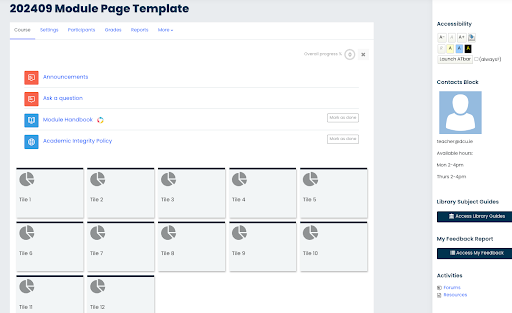One of the advantages of Moodle LMS is the flexibility that it gives you for course design. Moodle can be used for any topic, discipline or mode of delivery. However one of the negative knock-on effects of this flexibility is that it can result in huge diversity of course designs used for modules within the same programme, which can be detrimental to the learner experience. In the most recent episode of The Moodle Podcast, Mark Glynn, Head of Business Development EMEA, highlights the profound impact of Moodle Course Templates on higher education and corporate learning environments.
This blog post explores why course templates matter, their benefits, and best practices for implementation. Whether you’re an educator, eLearning designer, or Moodle user, this post will help transform your eLearning experience.
Why Course Templates Matter
Enhanced Consistency
One of the most significant advantages of Moodle course templates is consistency. Imagine a student juggling multiple courses, each with a different layout and navigation. Consistency in course design allows students to focus on learning rather than adapting to new interfaces. This uniformity creates a seamless learning experience, reducing distractions and enhancing engagement.
Simplified Navigation
Navigating through various course layouts can be confusing. Course templates streamline this process, making it easier for students to find what they need. With a standardised design, students spend less time searching for assignments, discussion forums, and resources, increasing their productivity and satisfaction.
Reduced Cognitive Load
Inconsistent course designs can overwhelm students, increasing their cognitive load. Templates reduce this burden by providing a familiar structure, enabling students to concentrate more on the content rather than the format. This reduction in cognitive load is crucial for effective learning.
Benefits of Course Templates
Improved Accessibility
Moodle course templates can be designed with accessibility in mind, ensuring all students can benefit from the course material. Features like clear navigation, alternative text for images, and consistent use of headings make content more accessible to students with disabilities.
Standardised Experience
Templates ensure a standardised experience across courses, making it easier for students to transition from one course to another. This is particularly beneficial in higher education, where students often take multiple courses simultaneously.
Faculty Efficiency
For educators, course templates save time and effort. Instead of building a course from scratch, instructors can use pre-designed templates, allowing them to focus on content creation and student engagement. This efficiency leads to better-prepared courses and a more enriching educational experience.
Best Practices for Template Implementation
Faculty Involvement
Engaging faculty in the design process is crucial for successful template implementation. Involving educators ensures the templates meet the specific needs of various programs and subjects. Collaboration leads to more effective and widely accepted templates.
Customisation for Specific Programs
A one-size-fits-all approach rarely works. Customise templates to align with the unique requirements of different programs and faculties. For instance, a template for a science program might include features that differ from those needed in humanities courses.
Continuous Improvement
Templates should evolve based on feedback from both faculty and students. Regularly updating templates ensures they remain relevant and effective. Encourage feedback to identify areas for improvement and incorporate new features as needed.
Faculty and Student Engagement
Collecting Feedback
Gathering feedback is essential for refining course templates. Both faculty and students can provide valuable insights into what works and what doesn’t. Use surveys, focus groups, and direct input to gather this feedback.
Iterative Improvements
Implementing changes based on feedback keeps templates current and useful. Make iterative improvements to address any issues and incorporate new ideas. This continuous enhancement process ensures that templates evolve alongside educational needs.
Encouraging Adoption
Promote template usage by showcasing their benefits and providing training for faculty. Demonstrating how templates improve the learning experience and save time encourages widespread adoption. Offer workshops and support to facilitate a smooth transition.
Real-World Impact
Success Stories
Mark shared a compelling success story of using reports to track template adoption. By analysing data, the team at DCU demonstrated the effectiveness of templates in enhancing the learning experience. This data-driven approach not only showcased the benefits but also fostered friendly competition among faculties.
Maintaining Quality
Maintaining template quality year after year is crucial. Regular audits and updates ensure templates remain effective and relevant. Continuous monitoring and improvement uphold the high standards set during the initial design phase.
Long-Term Benefits
The long-term benefits of using Moodle course templates are evident in the improved learning outcomes and enhanced user experience. Templates provide a solid foundation for consistent, accessible, and engaging courses that benefit both educators and students.
Conclusion
Moodle course templates are a game-changer in the world of eLearning. They enhance consistency, simplify navigation, and reduce cognitive load, making the learning experience more effective and enjoyable. By involving faculty, customising templates, and continuously improving them based on feedback, you can create a standardised yet flexible learning environment.
Ready to enhance your courses with Moodle templates? Our eLearning consultants provide expert guidance and custom Moodle solutions to elevate your eLearning experience. Whether you’re an educator or part of an institution, our consultancy services help you achieve your eLearning goals.


